Beyond the Basics of Lorcana - Part 2: Ink, Probability, and Deck Archetypes
(This blog has moved to wordpress: https://thetheoryoflorcana.wordpress.com/)
Part 1 Homework Answers

The "textbook" answer I was looking for was for you to come to the conclusion that Ariel - On Human Legs is a below-average, "bad" card. For starters, its strength and willpower is lackluster when we compare it to her peers. She doesn't quest for as much as some of her peers (Another way we can say this is that she is not aggressive enough since aggression in this game is how fast a character can help you reach the win condition of 20 lore)


Furthermore, her strength and willpower is lackluster compared to other peers


And finally her special effect is a detriment: she cannot sing songs while all her peers can.
BUT, you, the astute reader might say: "Hey wait a minute, didn't Duckie and Steadfast's Amber Ruby Collaboration include Ariel? And you would be right! And so the secret lesson is:
The context of the other, competitive decks and the available cards in the format is another critical factor in deciding whether a card is bad or good
Their deck is limited to Amber and Ruby cards and needs to plop something on the board that has a decent stat line (aka "body"), can progress our plan of going to 20 lore (2 lore is an above-average quester), and has high willpower to heal and draw cards (4 is fine). With this lens, Ariel is actually great for this deck's strategy. So again, context.
Part 2: Ink, Probability, and Deck Archetypes
Ink and Uninkables
Inkable cards are Lorcana's default: they allow us the option to forgo using that character or action and turning it into ink - this is critical as we cannot play any card without at least one ink. In fact, we usually want multiple ink as cards with powerful effects usually cost higher inks.

Maleficent - Monstrous Dragon has a crazy 7 attack, quests for a respectable 2 lore, and can even banish a character when she comes into play! But to play her, you need a whopping 9 ink - another way to think about this, instead of playing 9 cards, you need to devote them to your inkwell, and that's a lot.
You'll notice that almost all the vanilla cards we've discussed are inkable, and I think it's pretty clear that the game developers were judicious in deciding whether a card is inkable or not.
If you were to look at uninkable cards, you would probably notice that they are either cards that are powerful or cards that have a unique effect.


Currently, Lilo and Maleficent are the only 1-ink cards that can quest for 2 lore. It seems Ravensburger has deemed them so powerful that they should come with the drawback of being uninkable.

Peter Pan's Shadow has a unique effect - it is evasive, has rush, and gives your other rush characters evasive. This card isn't widespread in currently competitive decks, but he does see some play in decks that play many rush characters yet cannot counter evasives. This card illustrates Ravensburger's apparent design philosophy of uninkables being specialized cards.

Belle also has a specialized effect: when your opponent has no cards, she can now quest for an additional 2 lore (total of 3) which is quite a lot for a 3-ink with 2/4 stats. However, thus far in Rise of the Floodborn, Belle has not seen much competitive play - the issue is that it's actually very difficult to rid your opponent of their hand in a consistent manner AND then take advantage of Belle. I use her to illustrate the point that just because a card is uninkable does not necessarily make the card powerful.
In an ideal world, we would play decks of fully inkable cards. However, given the examples above, there are two primary reasons we play uninkables:
- They afford us a powerful card that is in line with our deck's strategy. For example, Lilo - Making a Wish and Maleficent - Biding Her Time have seen a lot of play in aggressive decks that want to get to 20 lore as fast as possible.
- They afford us a unique effect that our deck appreciates (some people call this a tech card). Maybe your deck has no ways to deal with evasives, but has a lot of rush characters. Suddenly, Peter Pan's Shadow becomes an amazing inclusion.
Ok, so how many uninkables can we afford to run? To answer this question, we need to talk about probability.
Probability
"10 uninkables is too much"
"20 uninkables is too much"
"30 uninkables is too much"
"13 uninkables is too much"
How many times have you heard the quotations above? To objectively answer the question of "how many uninkables is too much?" we need to talk about some math. I can hear the groans already, but I will convince you that it's worth learning. Have you ever been playing a game and had these kinds of thoughts in your head?
"I have 0 songs in hand and I have played no A Whole New Worlds. I want a Whole New World to refill my hand and I play the maximum 4 copies in my deck. I have an Ariel - Spectacular Singer in hand that I can play. If I play her, will I be able to draw A Whole New World?"
"I'm losing and have a Gaston - Intellectual Powerhouse in my hand. I REALLY need to draw Be Prepared to stop me from losing the game. I've already gone through half my deck and have seen 0 of them. I KNOW I have 4 of them in my deck. What are the chances I can draw a Be Prepared?"
You could just throw your hands up into the air, mumble something about the heart of the cards, and then try to play the card. OR you could learn how to approximate the answer so that you can make a better play.
It turns out that drawing cards without putting them back ("Without Replacement") is explained by something called the Hypergeometric Distribution. You can read about the behind-the-scenes math if you want, but I'm going to skip to its application: you can use this handy Calculator by Stat Trek to calculate it.
There is actually an excellent, free TCGPlayer Article that explains probability theory as it pertains to Lorcana. I won't re-invent the wheel here, but I'll go over a basic scenario to show you the calculator, as well as answer the gameplay questions I posed above.
Here is an example calculation from Stat Trek to answer a simple scenario: if my deck is 60 cards, I run 40 inkables (20 uninkables), and I draw my opening hand of 7 cards, what is the chance I see at least 1 inkable card? Here is what I've entered to set this up:
The "Population size" is the number of cards in the thing you are drawing from - usually your deck. My deck is 60 cards, so I enter 60.
The "Number of successes in population" is the number of cards in your deck that you are wanting to draw. There are 40 inkables in my deck, so I enter 40.
The "Sample size" is the number of cards you are actually drawing. To draw my opening hand, I take 7 cards from my deck, so I enter 7.
The "Number of successes in sample" is the number of cards I need to draw. We are asking about 1 inkable, so I enter 1
Each of the things the calculator spits out at us may we relevant to the question we're asking:
"Hypergeometric probability: P(X=1)" is the probability that we EXACTLY find the number of successes. Here, this means that we have a 0.00401 = 0.401% chance of drawing EXACTLY 1 inkable, which we are not really interested in.
"Cumulative probability: P(X<1)" is the probability what we draw LESS than the number of successes. Here, this means we have a 0.000201 = 0.0201% chance of drawing LESS than 1 inkable, which means no inkables, which is very low
"Cumulative probability: P(X≤1)" is the probability what we draw
LESS than or EQUAL to the number of successes. In this example, we don't care about this number because it is the chance that we draw 1 inkable OR no inkables.
"Cumulative probability: P(X>1)" is the probability what we draw GREATER than the number of successes. Here, we don't particularly care about this number either, as it is the chance that we draw 2 inkables or more.
"Cumulative probability: P(X≥1)" is the probability what we draw
GREATER than or EQUAL to the number of successes. This is the chance that we draw AT LEAST 1 inkable, and you can see it is very high, at 0.99979 = 99.979%
From the TCGPlayer article, with the so-called "Reasonable Mulligan Strategy," the author comes to the conclusion that you should run no more than 15-19 uninkable cards in a deck of 60. The number is not a hard and fast rule as your mulligan is actually influenced by more than just math: it is also influenced by the actual cards you want to see in your opening hand! However, 15-19 is a good range to keep in mind when you are deckbuilding.
So let's tackle the Ariel question. A modern, competitive deck such as the Pax Winner's Steelsong Flute Deck runs 20 songs with 4 A Whole New World. On turn 3, you have drawn approximately ~10 cards, so your deck has 50 remaining. Ariel - Speculator Singer allows you to see the next 4 cards in your deck. You have played no A Whole New World Thus:
It's about 29%, which is not impossible, but not that great. You may ask: KDramaAndCardFan, what was the whole point of calculating that, because it only gave me a headache? Well, it can actually inform your gameplay! Consider this:
- That Steelsong deck REALLY wants to sing A Whole New World early in the game in many matchups. If you already have an Ariel in your starting hand, how aggressively should you mulligan for A Whole New World? The answer is extremely aggressively: we've proven that if you don't have it, you only have about a 3 in 10 chance of drawing it off an Ariel. If the matchup is such that you will basically lose the game if you never play it, you should try very hard to get it in your opening hand.
- How many songs should you run to consistently find a song with Ariel? You could say "a lot" but it's probably better to have a more solid answer. I'll do the math for you in this case: if we are only considering the scenario where it is Turn 3 and you have no songs, a 20-song deck will get you an 88.1% chance to draw a song, which is amazing. If you cut that to 10-songs, it goes down to 60%, which is quite a drop.
There are more questions you can think about that are actually relevant to this deck: questions such as in the late game, when I have half my deck or less and have already drawn some songs, will I likely find songs with Ariel? (Usually, the answer is no - this may make you more likely to want to use Ariel as ink!)
I will leave the Gaston problem as homework. For now, let's move on from math purgatory.
Ink Curves and Deck Archetypes
Now, we understand the purpose of ink and uninkables and how many to play. But, now we have a fuzzier subject to talk about: how many low and high cost inks you should play. You may have heard of this concept called your deck's "Ink Curve." There is no perfect ink curve and the kind of curve you will end up constructing in your deck depends on the goals of your deck.
We could try to under this question using math and the hypergeometric distribution, and there is merit to doing so, but I would claim that gameplay and the actual effect of cards is a more important deciding factor here. So let's look at some recent, competitive decks and how they construct their curves:
Here is RMB's (A Top Pixelborn Player) Amber Amethyst Hyper Aggro list. The Ink Curve looks like this:
You'll notice something interesting: this deck does not run ANY cards that cost more than 4-ink. How does this deck seek to win the game?




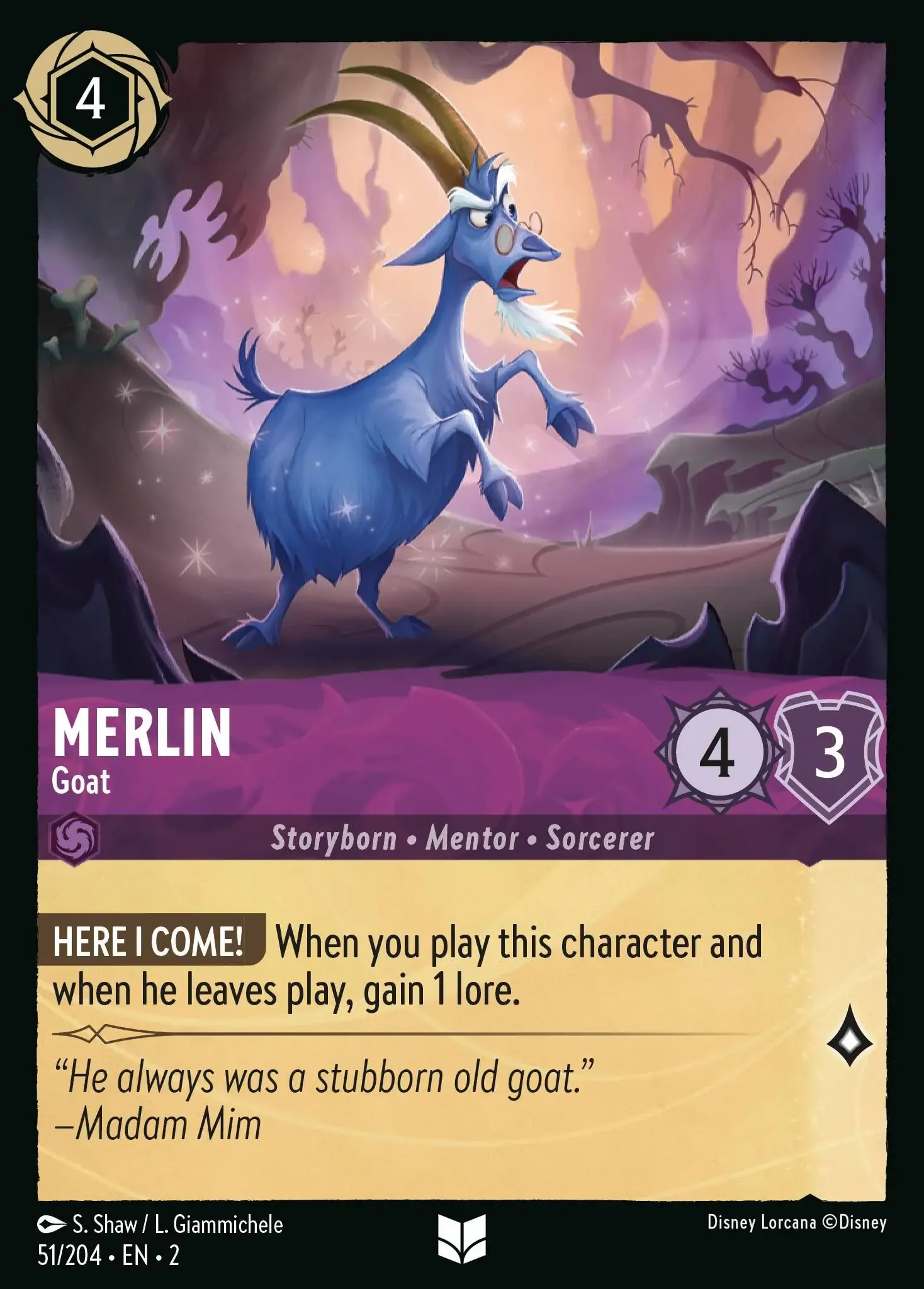
This deck runs a LOT of high-lore questers and cards that are designed to maximize lore gain such as Arthur and Merlin - Goat. Sometimes, you might hear of these kinds of cards referred to as "threats," "pressure," or cards that "demand answers."
As previously discussed, an aggressive strategy in Lorcana is synonymous with fast questing to 20 lore to win the game. As we see here, another feature that aggressive strategies and decks tend to have is that they are heavy on low-inks - another way we can say that is that they have a "low curve." We tend to call these decks Aggro decks.
Aggro decks try to speed to 20 lore as fast as possible and tend to feature low ink-curves
Here's an old school deck from The First Chapter to illustrate the next deck archetype. This is Steadfast's First Chapter Ruby Amethyst Hyper Control.
The curve looks markedly different from the Aggro deck: we have quite a lot of 3-cost cards, and we even have expensive 7, 8, and 9 cost cards. How does this deck seek to win the game?






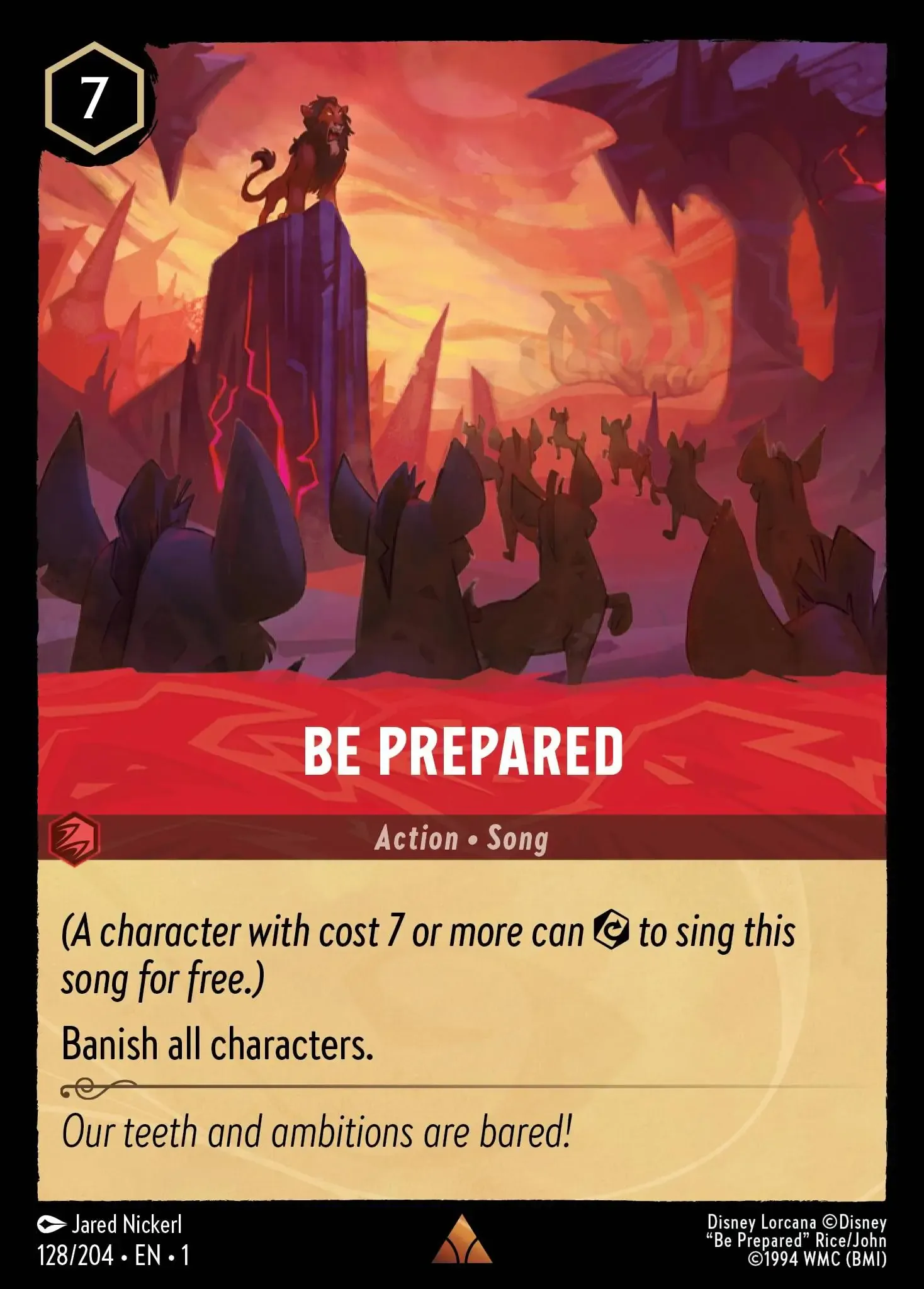
In contrast to aggro, this deck wants to try to stall the game with cards that slow or stop your opponent's ability to quest to 20 lore. In other words, this deck provides "responses" or "answers" to stall the game until it can build up a big inkwell to play powerful, high cost characters like Elsa or Maleficent. If this deck is able to accomplish that goal, then the opponent is stopped dead in their tracks and this deck is able to close out the game by questing with their own, high-lore questers. This is a Control deck
Control decks try to slow or stop your opponent's lore rush and tend to feature high ink curves
Next up, we'll go back to Pax Winner's (Dave Pendergrass) Steelsong Flute Deck
This curve is in-between the two we've just seen: it does feature a lot of low-cost cards, but not as extreme as the aggro deck. It also has some higher cost cards, but nothing higher than 7. How does this deck seek to win the game?
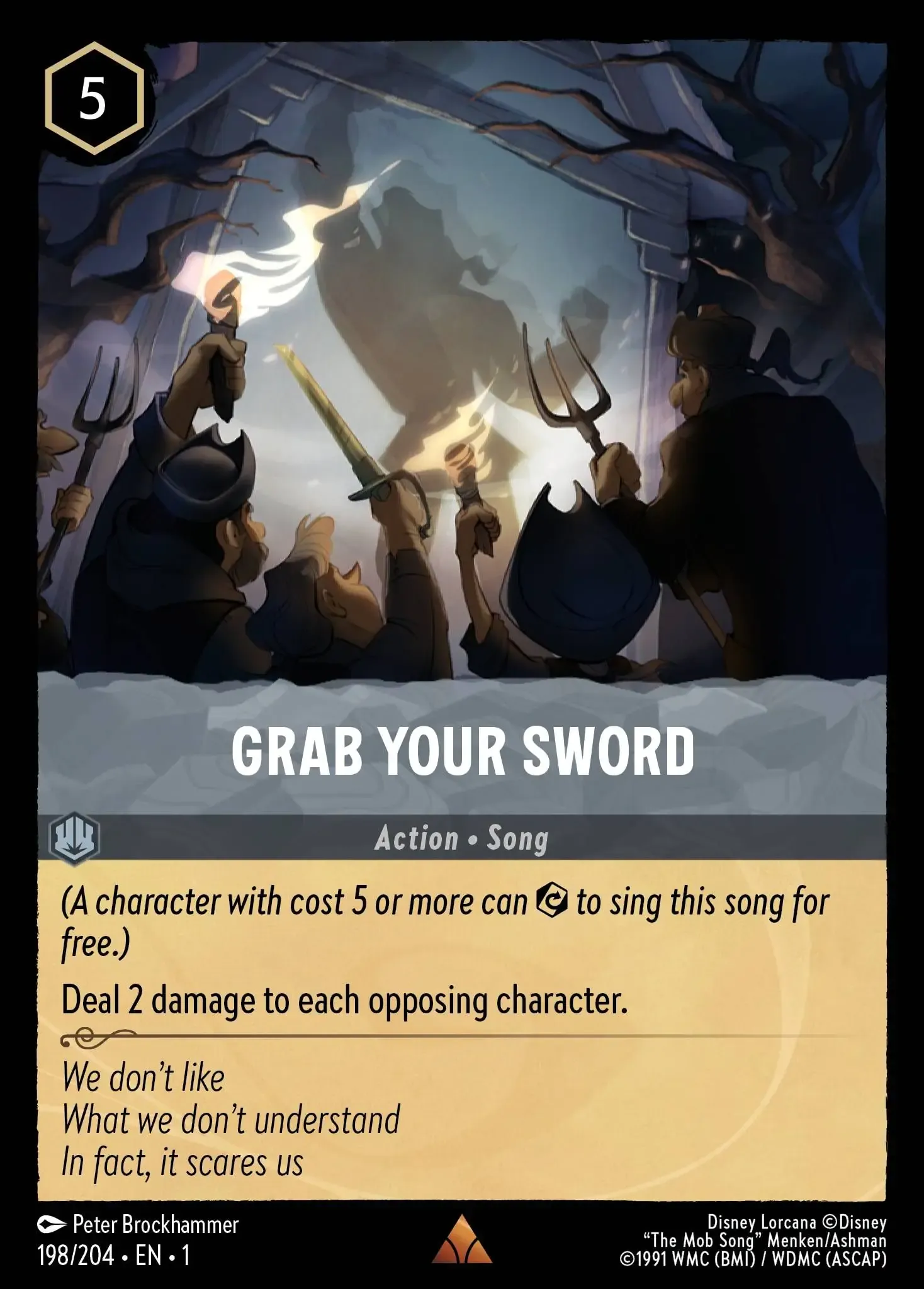
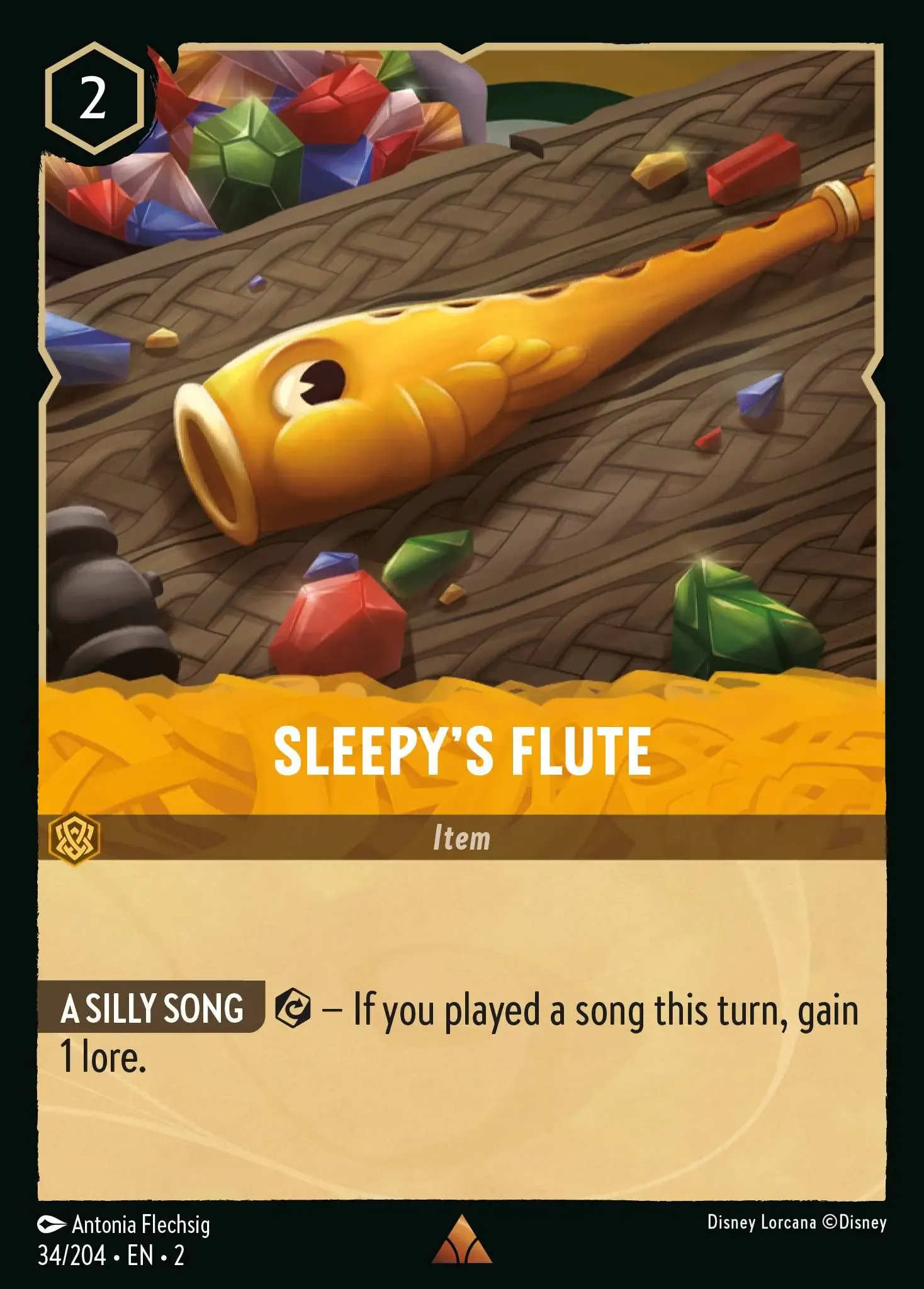
This deck is kind of in-between the two decks we've seen: on the one hand, it defining card, Sleepy's Flute, is a way to put pressure on your opponent by providing 1 lore per turn every time a song is sung. On the other hand, this deck also provides answers against more aggressive decks in the form of damage ("removal") cards such as Grab Your Swords. This is a midrange deck
Midrange decks have tools to stop your opponent's lore rush, but usually not as much as Control. They also have aggressive lore rush methods, but usually not as much as Aggro. They are in an in-between area.
Why both classifying decks? You may have encountered this piece of card game wisdom: Aggro decks tend to beat control decks. Control decks tend to beat midrange decks. Midrange decks tend to beat aggro decks.
Aggro > Control > Midrange > Aggro
This serves as a framework for us to explain why matchups are the way they are and help us understand how to play the game in a particular way:
Aggro tends to win against control because control struggles to keep up with the speed of the aggro deck. Consider this card

Be Prepared against an army of characters is devastating yes, but what if Aggro has already won by Turn 5? Then control will never even get a chance to play this card!
Control tends to win against midrange because midrange usually lacks the absolute card quality that control has and also isn't as fast as aggro, so it unfortunately allows control to each the high inks that it needs to play their responses. Consider this card differential:
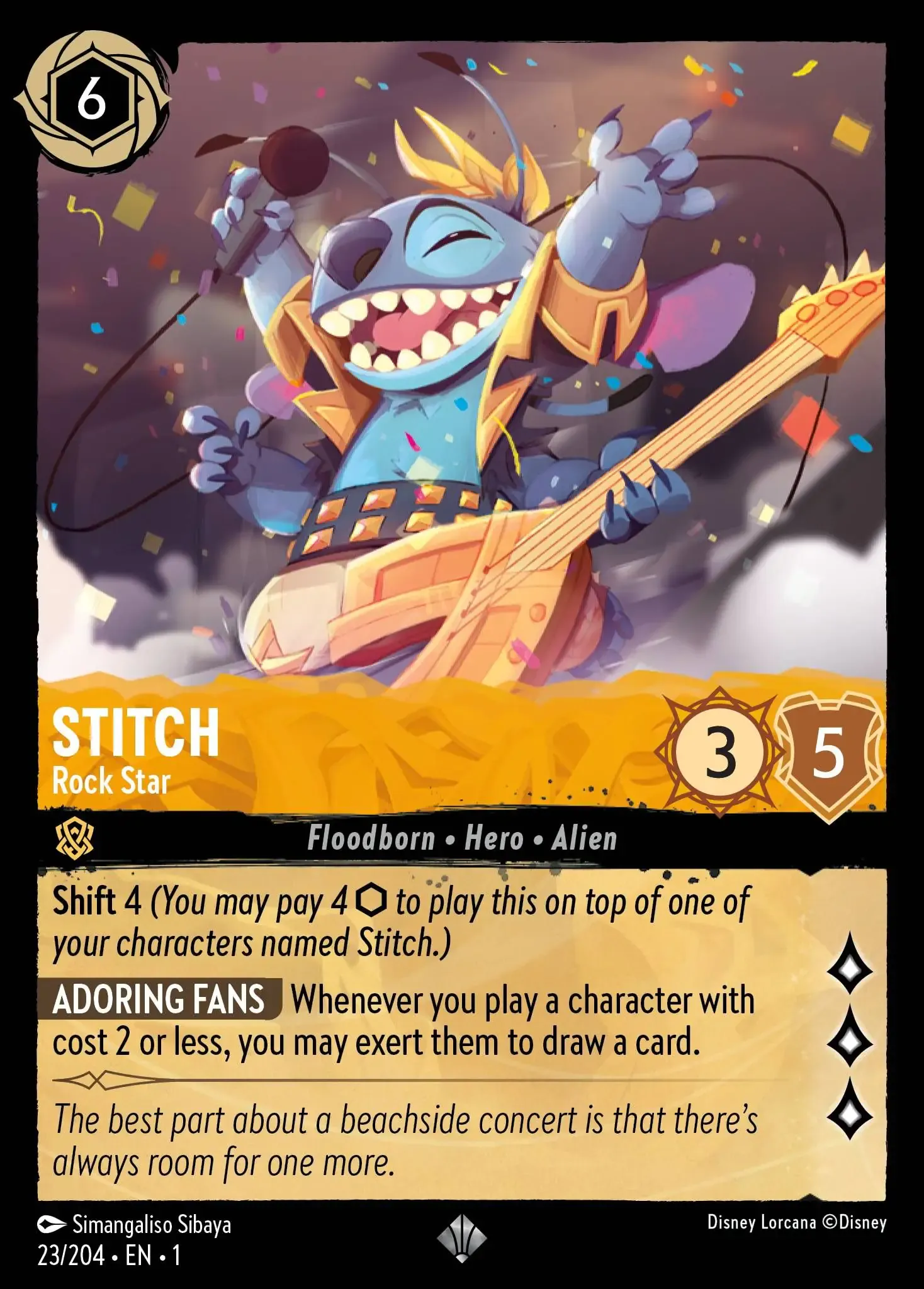

The midrange steelsong has an excellent card in Stitch Rock Star. But it is directly countered by Aladdin - heroic Outlaw, who can not only banish Stitch in a challenge, but gains 2 lore for doing so!
Midrange tends to win against aggro because their responses tend to be cheap and powerful enough to slow or even completely stop aggro in their tracks. Consider this combination:



Any aggro player is probably very familiar with this devastating combination: the midrange player with shift Tinker Bell on Turn 4 and sing Grab Your Sword to do a total 3 damage to the entire field. This is usually enough to completely wipe the aggro player's board, usually allowing the midrange player to takeover the game.
So in summary, we have seen how different deck archetypes construct different ink curves in different ways due to the different ways in which they want to try to win the game.
There is one more critical idea to discuss before moving on. The deck archetypes can also help us understand your "role" in a given game:
In every matchup and on every turn of gameplay, no matter what deck you are playing, you will have a choice whether to act as the aggressor (the "Aggro" or the "Beatdown") or as the person that wants to provide the responses (the "Control"). One of these options increase your likelihood of winning whereas picking the wrong choice increases your likelihood of losing the game.
This idea was famously epoused by Mike Flores who wrote this Magic the Gathering Article. It's a little hard to read if you don't know how to play Magic the Gathering, but the idea is highly relevant in Lorcana, and is another reason we try to classify decks.
Wrap-up and Homework
That was quite a lot of information, but we are in the full swing of things, so I hope you are enjoying this!
Here are two things to think about to try to apply what we have discussed here.
1. Calculate the Gaston scenario. Here it is again
"I'm losing and have a Gaston - Intellectual Powerhouse in my hand. I REALLY need to draw Be Prepared to stop me from losing the game. I've already gone through half my deck and have seen 0 of them. I KNOW I have 4 of them in my deck. What are the chances I can draw a Be Prepared?"
- Your deck is 60 cards
- Half your deck means you have 30 cards left in your deck

2. The Pawpsicles control deck is a popular deck in Rise of the Floodborn. Here is Phonetic's list from Dreamborn. What features make it a control deck?

Comments
Post a Comment